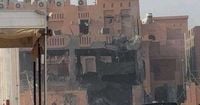On September 10, 2025, the Gaza Strip city of Khan Yunis awoke to a fragile silence, marking the end of a siege that had gripped the city for nearly two weeks. The Israeli occupation’s blockade, which spanned approximately 10 to 15 days—or about 350 hours—left a deep scar on the city’s residents, particularly the roughly 4,100 people who found themselves trapped by the military cordon. Among them were children, women, and the elderly, all forced to endure a relentless deprivation of basic necessities.
According to multiple humanitarian organizations and local sources, the siege was imposed in the wake of intensified Israeli military operations in Gaza. Over 200 shells rained down on the city during this period, as Israeli airstrikes pummeled various locations throughout the Gaza Strip. The attacks resulted in significant civilian casualties and widespread destruction, compounding an already dire humanitarian situation. Roads and water networks were badly damaged, further restricting movement and access to vital services.
As Al-Quds reported, the siege was not officially announced by Israeli authorities, but its impact was unmistakable. Residents of Khan Yunis described harrowing scenes: families forced to shelter in damaged residential towers, many of which stood between ten and fifteen stories tall and housed over 200 apartments. These buildings had become a last refuge for thousands who had already been displaced from their original homes elsewhere in the Gaza Strip. Around 3,500 people sought shelter in makeshift tents—about 350 in total—even though these flimsy structures offered little protection from the elements.
"We had no food, no water, no medicine, and no electricity for days," said a local resident, echoing the accounts collected by humanitarian workers on the ground. The city’s hospitals, already strained by months of conflict, faced acute shortages of medical supplies and fuel. Ambulances struggled to reach the wounded amid the rubble-strewn streets, and doctors were forced to make agonizing choices about who could be treated with the limited resources available.
The siege of Khan Yunis was part of a broader campaign of military pressure exerted by Israel across the Gaza Strip. According to Al-Quds, Israeli forces systematically destroyed residential towers in Gaza City, displacing thousands more and targeting shelters that housed people who had already been forced to flee their homes. The destruction extended to 350 tents that provided scant cover for 3,500 refugees. These actions, humanitarian groups warned, amounted to collective punishment and exacerbated the suffering of civilians caught in the crossfire.
Throughout the blockade, Israeli officials issued stark warnings to the Palestinian resistance. The Israeli Minister of Defense threatened to reduce Gaza City to rubble unless all Israeli hostages—both living and deceased—were released, and unless Palestinian fighters surrendered unconditionally. These threats, described by Al-Quds as “genocidal,” were widely condemned by international legal experts and human rights advocates, who argued that such rhetoric and tactics violated the norms of international law.
The humanitarian impact of the siege was immediate and severe. Aid convoys were unable to enter the city, and the already meager supplies of food, water, and fuel dwindled rapidly. Residents resorted to collecting rainwater and rationing whatever provisions they could find. Children suffered from malnutrition, and the elderly struggled to cope with the lack of medical care. The blackout that accompanied the siege plunged neighborhoods into darkness, heightening the sense of isolation and fear.
As the blockade dragged on, reports of civilian casualties mounted. Israeli airstrikes targeted not only military sites but also densely populated residential areas, leading to the deaths of numerous non-combatants. The destruction of infrastructure—roads, water pipes, and electrical grids—further hampered rescue efforts and deepened the crisis. Humanitarian organizations described the situation as a “catastrophe,” warning that the city was on the brink of a full-scale humanitarian collapse.
The end of the siege came without fanfare or official explanation from Israeli authorities. Local sources and humanitarian groups confirmed the lifting of the blockade, but the reasons behind the decision remained unclear. Some speculated that mounting international pressure and the worsening humanitarian situation had forced Israel’s hand, while others pointed to the resilience of the local population and the continued resistance of Palestinian fighters as key factors.
Despite the easing of restrictions, the aftermath of the siege left Khan Yunis reeling. The city’s infrastructure lay in ruins, and thousands remained displaced, their homes either destroyed or rendered uninhabitable. Humanitarian organizations rushed to deliver emergency aid, but the scale of the need far outstripped available resources. “We are facing a humanitarian disaster,” one aid worker told Al-Quds. “People have lost everything, and the trauma of what they have endured will linger for years.”
The siege of Khan Yunis was not an isolated event. Across the Gaza Strip, Israeli military operations continued, with airstrikes targeting a range of locations and causing further civilian casualties. In addition to the devastation in Gaza, Israeli forces launched attacks on targets in Syria’s Homs, Tartus, and Latakia provinces, as well as strikes in southern Lebanon and Yemen. These actions drew sharp criticism from international observers, who accused Israel of escalating regional tensions and violating the sovereignty of neighboring states.
The political fallout from the siege was also significant. Israel’s relations with the international community, already strained by months of conflict, took another hit as foreign governments and humanitarian agencies condemned the blockade and its impact on civilians. The Israeli Foreign Minister’s harsh rhetoric against critics—described by Al-Quds as “a barrage of insults”—did little to assuage concerns about the conduct of Israeli forces in Gaza and beyond.
For the residents of Khan Yunis, the end of the siege brought only a brief respite. The city remains on edge, bracing for the possibility of renewed violence and further hardship. Yet amid the devastation, stories of resilience and solidarity have emerged. Neighbors banded together to share what little they had, and volunteers worked tirelessly to clear debris and deliver aid to those in need. As one resident put it, “We have lost so much, but we have not lost hope.”
The scars of the siege will not heal overnight, and the challenges facing Khan Yunis—and the Gaza Strip as a whole—are immense. But for now, the lifting of the blockade offers a glimmer of relief in a region all too accustomed to suffering and uncertainty.




